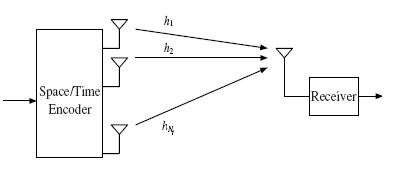Transmit spatial diversity is a newer phenomenon than receive diversity and has become widely implemented only in the early 2000s. Because the signals sent from different transmit antennas interfere with one another, processing is required at both the transmitter and the receiver in order to achieve diversity while removing or at least attenuating the spatial interference.
Transmit diversity is particularly attractive for the downlink of infrastructure-based systems such as WiMAX, since it shifts the burden for multiple antennas to the transmitter, which in this case is a base station, thus greatly benefiting MSs that have severe power, size, and cost constraints.
 Additionally, if the multiple antennas are already at the base station for uplink receive diversity, the incremental cost of using them for transmit diversity is very low. Multiple-antenna transmit schemes—both transmit diversity and spatial multiplexing—are often categorized as either open loop or closed loop. Open-loop systems do not require knowledge of the channel at the transmitter.
Additionally, if the multiple antennas are already at the base station for uplink receive diversity, the incremental cost of using them for transmit diversity is very low. Multiple-antenna transmit schemes—both transmit diversity and spatial multiplexing—are often categorized as either open loop or closed loop. Open-loop systems do not require knowledge of the channel at the transmitter.
On the contrary, closed-loop systems require channel knowledge at the transmitter, thus
necessitating either channel reciprocity—same uplink and downlink channel, possible in TDD—or more commonly a feedback channel from the receiver to the transmitter.
The most popular open-loop transmit-diversity scheme is space/time coding, whereby a code known to the receiver is applied at the transmitter. Although the receiver must know the channel to decode the space/time code, this is not a large burden, since the channel must be known for other decoding operations anyway.
Space/time coding was first suggested in the early 1990s before generating intense interest in the late 1990s. Of the many types of space/time codes, we focus here on space/time block codes (STBCs), which lend themselves to easy implementation and are defined for transmit diversity in WiMAX systems.
A key breakthrough in the late 1990s was a space/time block code referred to as either the Alamouti code—after its inventor [1]—or the orthogonal space/time block code (OSTBC). This simple code has become the most popular means of achieving transmit diversity, owing to its ease of implementation—linear at both the transmitter and the receiver—and its optimality with regards to diversity order. The simplest STBC corresponds to two transmit antennas and a single receive antenna.